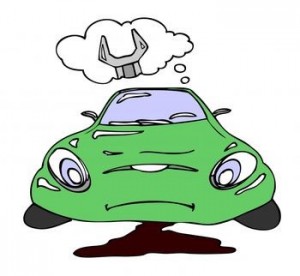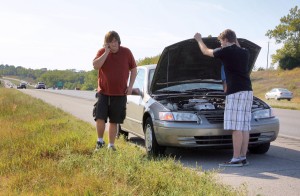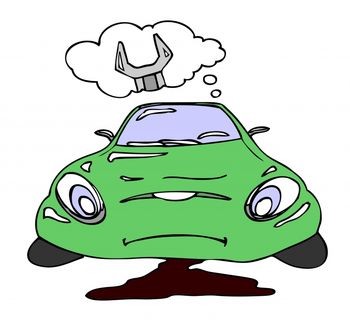People sometimes pre-emptively get rid of a car simply because it’s “old” or “has high miles.” Even if it’s still running great – and hasn’t given them any real trouble so far – they fear that if they hang onto it, problems are likely to arise.
It’s this fear – the sense of unease that accompanies the unknown – that pushes a lot of people into a new (or newer) car before they really need one.
Now, it’s generally true that an older car is more likely to need repair or maintenance than a newer one. And that higher miles means more wear – which means things like brake pads, suspension components, tires – etc. – will probably require replacement sooner rather than later.
But that doesn’t mean the car itself isn’t worth keeping – much less that it’s no longer a car you can count on.
Keeping an older car viable as everyday transpo comes down to two things:
Being mechanically observational – and being at least somewhat mechanically competent.
It’s not necessary to actually be a mechanic – or to actually work on cars.
But knowing something about how cars work – the basics – will enable you to anticipate potential problems before they become problems – and keep little problems from becoming big ones. That, in turn, will help you keep an older car running reliably for longer. 
A car-hip person, understands, for instance, how a car’s brakes work – the principle behind it (hydraulic pressure distributed through a system of steel pipes applying clamping pressure; the use of friction to slow the car down) and knows, at least, in general terms, what the various parts are and what they do.
Because he has some knowledge of how a car’s brakes work – and which parts do what – he will know almost instinctively when they’re not working properly – as well as the steps one ought to take to make sure they continue to work properly. He will know, for example, that after a given interval of time/miles, it is probably time to pull a wheel and take a look at the pads; to check whether they ought to be replaced before they wear out completely and so avoid chewing up the much more expensive rotors. He will pop the hood fairly regularly – and check the fluid level in the master cylinder. He will also know what color the fluid ought to be – and that if it’s not the right color, it probably ought to be changed. Before it rots out the hydraulic system (lines, calipers, ABS pump, etc.) from the inside. 
A car-hip person will be more attuned to the various noises – and smells – that portend trouble and take early action (either himself or through a mechanic) before a small, inexpensive thing (e.g., worn pads) becomes a big, expensive thing (ruined rotors). When he feels vibration through the steering wheel – or the car pulls to one side – instead of fear, he’ll realize it’s probably just an out of round rotor – fairly easily and fairly inexpensively fixed.
It doesn’t mean the car’s falling apart – or that it’s not otherwise safe to drive anymore. No need to panic – much less head frantically to a dealership – where the smell of desperation is an aphrodisiac to new car salesmen.
The car hip don’t sweat the appearance of a few drops of oil on the garage floor – because they know that it is oil (knowing the difference between oil and, say, coolant – or transmission fluid) and that it’s normal for older/higher miles cars to seep/drip a little – kind of like older people. But the car hip dude will be on the lookout for an increase in the dripping/seepage, which could portend a different problem.
A car hip guy or gal also knows to periodically check the oil, too. Older cars sometimes use more oil in the course of normal driving around newer cars (all cars use a little oil over time – the car-hip know that, too). This way, the oil level never runs too low – and he’s aware of any sudden increase in oil usage which might – again – suggest a problem that could grow into a big problem if not looked into. 
Same goes for all the other levels – and condition – of the various critical fluids: Coolant level, transmission fluid, power steering steering fluid – and so on. It costs nothing to check ’em, next to nothing to keep ’em topped off. But it can cost a lot if you fail to check ’em – and don’t keep ’em topped off.
A car-hip person isn’t driven to hysterics out by the “check engine” light coming on. He knows that it’s just the car’s computer “throwing a code” – and (very often) it’s something trivial and easily handled, such as replacing an O2 sensor . . . because he knows what an O2 sensor is – and what function it performs. He also knows where this component is located – and (roughly) what a new one ought to cost him.
Same goes for the whole car, as a system.
It is not necessary to be a trained mechanic or even a DIY adept – but you do need to be conversationally informed. Otherwise, you are at the mercy of your car – and the honesty (or not) of your mechanic. 
The non-mechanically knowledgeable person is oblivious – until something stops working. Usually, this happens “suddenly” without (from his non-observational perspective) without warning. It makes him nervous. He begins to distrust the car.
And that, in turn, causes him to feel an urgent need to replace it – even if all that needs replacing (or fixing) is some relatively little thing, after which the car will be ready for another 20,000 miles (or more) of payment-free driving.
The more you know about cars, the more secure you’ll feel about your car.
And probably, the longer you’ll be able to keep it – without it costing you much.
Either money-wise or angst-wise.
If you want to know more about becoming a professional wrencher, see here!
PS:This site is almost entirely reader supported now. No Google. (They blacklisted us – so we dumped them. See here for the full story about that.)
So, we need your support to make a go of it and keep EPautos rolling. If you like what you see, please consider supporting this site. The link to our “donate” button is here.











“and that it’s normal for older/higher miles cars to seep/drip a little — kind of like older people.” …………….. hahaha ! absolute gem of a line !
Eric, I have long been a fan of buying older, gently used vehicles, and have been very fortunate with every one I’ve owned. I agree that having a basic understanding of how a car works has helped eliminate the crapboxes that many are stuck with.
My most recent find is a 2001 Lincoln Town Car that I picked up with just 80,000. After changing the oil and putting in new plugs, I took it on a 2 week, 2500 mile trip visiting family. I averaged about 25mpg, and didn’t burn a drop of oil. I like this car so much, I’ve started looking for another one.
Great choice, Andy!
In fact, I got my father-in-law to buy the same car (2001 Town Car; loaded Cartier edition). He got a sweet deal on this one-owner, low-miles car – and drives it all over the country, literally. He lives in Stillwater, OK – and visits us (Virginia) twice a year, with stops in Ohio, Georgia and other points in between.
The TC is a superior long-haul/road trip car – and a very nice car to just knock around in locally, too.
When I do a brake job it is always new pads, rotors, hardware and greasing the slide pins. I have never worried about damaging the rotors, they are going to be replaced anyways.
Rich wrote, “When I do a brake job it is always new pads, rotors […] I have never worried about damaging the rotors, they are going to be replaced anyways.”
Uh, yeah. Is that ‘rich’ or imbecile clover?
Uh, no! It’s economics, clover. Brake rotors aren’t expensive.
Perhaps to you they’re not expensive, I surmise many would disagree with that outlook, especially when there’s no need to replace them.
I suppose if you’re wealthy it’s nothing. Just like throwing away twenty Dollar bills for the hell of it.
I don’t seem to recall reading anywhere or hearing anyone say that replacing something that does not need replacing fits into the habits of the wealthy.
Maybe it’s a good plan for NASCAR drivers and such? But we’re talking daily drivers here.
Do you throw away your socks after you wear them once as well?
Well, you found me out! I am actually John D. Rockefeller. I would not even bend over to pick up a hundred dollar bill; money for the plebs. Let’s see. I just priced rotors for my 1987 Honda Accord. $19.99 per side. Two year warranty. For the 1989 Honda Accord. Wow! We are all the way up to $28.99 per side. Two year warranty, of course. Here is where I really show off my wealth. 2007 Subaru. $33.99 per side. There. Take that! My main point being, I work on my own cars. The money I save by doing that is used to buy the parts I want. The time spent having rotors turned compared to the price of new ones is not worth the hassle of messing with an old rotor; if you can even find anybody around here to turn a rotor. They usually tell you to just buy new ones. And they are right! Yes, if I was unemployed I would nickel and dime everything. Have had to do that before. To me, these are not expensive parts of cars. Transmissions, engines, sensors, yes. Brake rotors, no. Oh, and I use my old socks as rags to clean off my new rotors!
Hi Rich,
You’re lucky!
Some late model rotors cost a small fortune.
And so do calipers.
By running the pads to the backing, you risk hurting them, too.
I admit to being a little OCD about maintenance!
@Eric – What is you opinion on the EBC thye package deals they offer with rotors. They claim their different colors of upgraded pads and rotors are the cats meow. Example : for my toyota the package of 3 different pads and 2 different upgraded rotors ranges between $100.00 and $275.00.
Hi Gary,
I’ve not had any personal experience with them. Apparently, the low-cost stuff is equivalent to OE and suitable for normal use street driving. The mid-range stuff offers superior resistance to heat-induced fading, as well as a firmer pedal feel, but at the cost of reduced service life. The top-of-the-line stuff is intended for high-performance street/track day use, etc. but has the disadvantage of poor performance (relative to the standard pads, etc.) until warmed up.
Yes, I did find you out, Rich.
You’re throwing away $20 to $34 per side, but you have Four , so that makes it: $80 to $136 Dollars you’re just throwing away.
How often do you do that?
So, yes, it looks like you do throw your brand new socks away after you wear them once. It’s about the same cost.
You talk about turning rotors. Who said anything about turning rotors? You said you just throw them away.
None of the shops in my city say to just throw a rotor away rather than turn them. You must live in Silly Valley?
I prefer quality parts on my vehicle. The Raybestos rotors for mine cost $137.27 each, that’s $549.08 without tax for all four.
If you have no problem throwing that kind of money away, in fact if you have no problem throwing any amount of money away, then ya, you’re the Rockerfella.
I used to run cars into the ground. Now I “trade em” when my odometer gets close to 50,000 miles. Why? for three reasons, trade in value is VERY high below 50,000 miles, a car needs no maintenance at that mileage and the third is having a new car under me should a financial collapse occur. Should there be a huge financial collapse I like the feeling that my car will last many many years barring theft or accident. Ok…..maybe a forth, I can afford it.
Hi Joe,
It’d be interesting to run the numbers on that… depreciation for most cars during the first 3-5 years is pretty significant. Now, if you got a really good deal on the car when you bought it – and are able to re-sell/trade it for a really good price – it might be enough such that you come out ok.
But I don’t see the upside of being perpetually in debt (constant monthly car payment) vs. a paid-for car that may not cost you anything beyond fuel and basic upkeep for many years after it’s paid for.
About a year ago, I did some rough figuring on the total cost of owning one of my trucks – a ’98 Nissan Frontier. I bought this truck about ten years ago for $7,200 with just under 70,000 miles on the clock. I’ve replaced the water pump and exhaust system, belts and hoses, did a major tune-up. Add a set of new tires. Oil/filter changes every six months.
About $1,000 in “upkeep” over the past ten years.
So, total outlay: $8,200.
Now, the truck is currently still worth about $4,000 – because it’s in good shape, but chiefly because it’s a 4WD pick-up in good shape. Cash for clunkers helped push the price of solid used 4WD trucks way up.
Anyhow, $8,200 less $4,000 is $4,200 – which is (again, roughly) about what this truck has cost me to own to date.
$4,200 divided by ten years equals $420 a year – or $35 a month.
Damn near free!
Also: I am paying much less for insurance (minimal,liability-only policy) and much less for property tax (big deal in my state).
Now, there’s nothing wrong with buying a new car – especially if you can afford it.
I just don’t see it being a way to save money.
damn Eric…. that was serious math! You are correct though. Yes its always cheaper to buy used and learn to do most repairs yourself. Back in the day (when I was younger) I was able to do top engine repair, swap trannys etc in my cars. I was a Mustang fanatic and owned many but living under the hood in the dead of winter is no longer a thrill at my age. Now I buy cars based on reliability and no longer need to do repairs. Newer cars are almost at the point of being untouchable by grease monkeys such as myself. Every aspect of current vehicles is computer controlled and built to last 100,000-200,000 before anything costly. It all comes down to what you can afford. I dont know anyone with enough money driving an old clunker. We all have our financial position in life and drive accordingly.
The idea of owning a new vehicle should there be a huge financial collapse scares the crap outta me.
Nothing screams, “I’ve got money and nice stuff to take!” more than a new shiny vehicle does.
Insert photo of Hollywood movie star outfitting fancy car with bullet proof glass, here x.
Not too mention, if you try to barter or haggle with someone and they see what you’re driving, it makes it harder to get a good deal, or try and low-ball.
YMMV, of course.
Also, just the thought of all the money that could be saved, or spent better elsewhere, instead of on a new car… whoa.
I think I’ll go out and rub some dirt on my 4×4 now.
@DS -Out here in California you can’t apply for welfare if your vehicle is valued over $1,800.00. Damn. DownShift, can i put my cars and bikes in your name?
the scam is to have everything in someone elses name or own garbage. Criminals or fruadsters ALWAYS follow this policy to avoid government confiscation. Buying an $1,800.00 clunker and leaving it next to your $80,000 Lexus (registered in moms name) is not uncommon.
@JoePA – I am looking at New Mexico incorporation for assets. Like J. Paul Getty said “Own nothing, control eveything”.
“The idea of owning a new vehicle should there be a huge financial collapse scares the crap outta me.”
You are correct in that driving a newer car attracts attention. My point was that a newer car would have more years left in it to ride whatever financial storm comes. I can in a moments notice change my newer car into a rag tag clunker looking bucket of bolts. The same goes for my personal appearance and home.
“The idea of owning a new vehicle should there be a huge financial collapse scares the crap outta me.”
This is why I own bikes – especially old bikes.
I have a 250 CC dual sport four-stroke, air-cooled, that will go just about anywhere, never gets less than 75 MPG, and cost me $2,000 (used) eight years ago.
Eric…every motorcycle I’ve owned costed more than my car in maintenance as I averaged 11,000 miles year. Motorcycles in the colder climates are toys and nothing more. Now I’m bikeless BUT I put my money into trading my car in every 2-3 years so its not all bad.
Hi Joe,
A lot depends on the bike. Something like my 250 Kaw, for example, is virtually maintenance-free. It takes about 1.5 quarts of oil, a filter – and that’s it for the oil change. Maybe $10 (using high-end synthetic oil) and you can literally do the job in 5 minutes with a crescent wrench or slip joint pliers.
Air filter – reusable.
No radiator or coolant.
Clean/adjust chain once a year. Replace chain/sprockets maybe every third year ($100 for that, assuming you do the work – and it’s not a tough job).
Clean the carb occasionally, adjust cables. Brake pads are less than $15 and take 10 minutes to swap out with very basic tools. Bleed the brakes occasionally – a pint of fluid, maybe $6.
Tires definitely don’t last very long relative to a car, but they’re very inexpensive. About $60 each – and they’ll last 2-3 years.
That’s pretty much it as far as maintenance costs.
My Kz900 – the CHiPS cop bike, without the fairing – is not much worse. Though a much larger, much more powerful bike, the inline four is still air-cooled and other than oil/filter changes, occasional valve clearance checks, it really doesn’t ask for much more.
I agree that bike is not what you’d want to be on when the weather gets cold… however, I have a fully faired ’83 Honda Silverwing Interstate with heated grips that is absolutely viable – without torturing yourself – when the weather’s cold. So long as it’s not freezing cold – and there’s no ice/snow on the road!
My other bikes get put away for the season after the first snow – chiefly because of road salt, which I don’t expose them to. But I’ll ride the Honda year-round, weather permitting.
Granted, there are days – including stretches of days – during the winter when riding is pretty much out, regardless of the bike. But, having the option is nice.
Ha! An $80,000 Lexus * is still * an $80,000 Lexus, no matter how much dirt you put on it.
Put as much trash as you want on your front lawn, the locals already know it’s a ritzy neighborhood, it won’t do any good.
RE: bikes.
You know, I’ve said it before, FerFal had examples of people being knocked off their bikes. That’s a big drawback.
I love bikes though, and that seems to be the Only downfall I can think of for them, except maybe Winter. …But even then, it’s doable.
@DS – That is waht steel toe boots, dual sport tires and acceleration are for. Geez.. now I have to think about tactical training and practice! It never ends!
“Steel toe boots, dual sport tires and acceleration.”
Yeah. I can see that. [Someday maybe I’ll get one too?]
At the same time,… I’ll never forget this one time I encountered a thin stand of wire strung out at about handle-bar height. …
A blindsiding is prolly about the same. ?
@DS – said “At the same time,… I’ll never forget this one time I encountered a thin stand of wire strung out at about handle-bar height. …”
DS, I don’t go to those bars anymore. 🙂
Ha! If *only* it was, ‘just a bar’.
Eric, what are your thoughts on plugging a smart phone app into an OBD2 capable car? I’ve used mine on multiple vehicles and it’s paid for itself many times over. Do you recommend any particular solution for tapping into the car’s computer telemetry?
Thanks.
Hi DB,
I’m not a Geek High Master (wish I were!) so I dunno!
Does your app let you access more info than just the code? (I have a scan tool that gives me the code as well as what the code means, the ability to re-set the check engine light – and so on. It wasn’t particularly expensive – about $120 IIRC.)
Hi Eric,
Yeah, a lot of the codes are public domain and there’s a lot of codes which are proprietary and manufacturer specific but the app (Torque) does a pretty good job of keeping up with them. I took great pleasure in turning off a reoccurring check engine light due to a small exhaust leak which gave a false positive indicating an oxygen sensor problem. The app has a large array of graphs and dials which are continuously updated by a stream of telemetry data from the engine.
I once had a problem with sporadic sudden power loss where the telemetry data was lost so the mechanic couldn’t figure out what the causal event was. So I recorded everything for a week saving the data to the phone. When it happened again I gave the codes to the mechanic who was then able to determine which sensor needed replacement.
The app cost about $5. There’s hardware which hooks into the RS-232 port and sends the data to the phone via Bluetooth. It costs about $100.
Sounds like the ticket, DBD!
I’ve wanted (for years) to end-run the Malfunction Indicator Light on an OBD-equipped vehicle sans catalytic converters. I am pretty sure it’s possible, just haven’t sorted out the details.
My F-150 ,300 in six, 4×4 is 22 years old and runs good. I do almost all m&r on it that is mostly things mentioned in your article plus replacing radiator, water pump, starter, various filters, belts, hoses, and seals over the years. Sensors have been going up lately and replaced the ECT, MAP, ATC sensors. Keep in mind this maintenance has been spread over 22 years so it is not much yearly. I don’t even want a new one, they are way to costly and after you add decent size tires to a 4×4 the sides are far to high for a work truck. Truck has served my well and I plan to keep it for many more years.
Ditto, Will!
Another poster mentioned the advantage of being in tune with the a car you’ve owned for many years. Knowing its quirks – as well as where things are, how to fix ’em (and so on).
I’ve been into ’70s-era GM F Cars since the ’80s, when I was in high school. I have owned six of them and know them so well I can almost work on them blindfolded. I know their weak points (helpful when shopping for one) and also lots of “tricks” when it comes to working on them.
Kind of like being married for a long time!
“Kind of like being married for a long time!”
Except that your car will be much more useful and give you far fewer problems than a typical modern wife will!
And it’s far easier and cheaper to trade a car in for a newer model. And your first car won’t get pissed or jealous if you decide you want a second one! =)
Dunno about you, but the longer you hold a car, I think you develop a brand loyalty based on the cars reliability and the ease at which you can work on it. I’m a big fan of Subaru’s for that reason… you can actually get at, and change the spark plugs!
Tom, that’s true for me too. Becoming familiar with the design and what it takes to maintain the car myself is the basis for my brand loyalty.
Hi Tom!
I did some work on our neighbor’s (2011) Subaru. Changing the oil turned out to be incredibly easy – easier than in any of my vehicles. Subaru thoughtfully located the oil filter in an easy-access position, routing the exhaust plumbing around it. You can almost do the job without tools.
I dig that!
I can drain the oil and change the oil filter on my 2002 Legacy without having to lift the car. Also, the oil filter is mounted vertically, so it’s possible to prime the new filter with oil before installing it.
Myles
I own a 2010 Subaru Legacy I bought used. Needed something to drive and I hated what was out there on the market new.
I will have the car paid off next year.
One reason I bought it was because it is easy to work on. You can practically take the entire car apart with a 10, 12 and a 14 mm wrench. No star, no torx, nothing tricky.
The other reason I bought the car was because of the durable and simple suspension design. I look at that first when looking at a car.
I had to get out of my favorite driving car (a 2003 Jaguar S-type) because week after week, I was replacing suspension parts. Other things were breaking as well.
I am not as opposed to buying new cars as many here, but I think I’m car savvy enough to look for cars that are easy to work on with cheaper repalcement parts.
Changing spark plugs on Subaru’s “flat” engines is a little tricky. On mine, I have to remove the intake tract and windshield washer bottle. Compared to an inline 4 it’s tricky. Compared to a transverse V-6, it’s a breeze.
I replaced them on my 2010 Legacy. Easy job. It just required removing a small battery and loosening a fuse box for access. I did the job in less than an hour. The dealer wanted $299.00 for that job. HA!
One thing to check, the gasket around the windshield. If it is not watertight water gets under it and then will rust, possibly making it impossible to ever replace the windshield. I caught the rust in time as it started to escape from under the gasket to the roof of the car. I ended up paying $1250 for a new windshield and new clear coat and rust repair over the car body. I remains unclear if the rust has been permanently repaired.
In general the windshield should be replaced as it slowly gets mottled. The tint gets sun bleached.
I’m about to tackle this with my ’69 Cutlass that I use as a daily driver. There is very little rust on the car, but I’m worried about what I’ll find when I pull the windshield to replace the leaking gasket.
https://www.facebook.com/EricPetersAutos
Great car, LF!
I wouldn’t sweat the windshield/rust issue too much. With cars of that vintage, removing and replacing the windshield is much easier than it is with modern cars (which have very tight tolerances, especially the trim). If there is rust underneath, the aftermarket will help you out – most of the pieces you’d need to replace are readily available.
That’s a car that’s worth spending money on!
Wow. Beautiful car. My brother had one during college. I wish he still did. Or I did.
He traded it in 1971 for a Toyota Celica (!), two years before the gas shortage. What a moron. I was only 8 at the time, but I couldn’t believe it.
Of course, he was in favor of the 55 mph speed limit when it was imposed, so you get an idea of what he was about.
I hope you can keep that car and fix it. It’s worth it.
If you have an older car in a damp area of the county you need to monitor the rust situation or it can get out of hand and force you to junk the car. National chains can deal with the dings and rust and put on new clear coat of a bit over $1000.
Damn it, Eric, stop spreading common sense around! I work for a living. I can’t afford new cars. If people start listening to this, I won’t get what they throw away anymore!
Seriously, though, very good article. I’ve watched many of my friends go nuts and buy a new car at payments that pretty much will mean it’s their home because of some stupid little thing like a brake rotor. I’ve done the majority of my own maintenance going on 3 decades now, and I will never understand why people don’t try to learn a bit about their wheels. Granted, I love cars and most people simply view them as a tool. But shouldn’t you know about your tools?
Thanks, Kevin!
Part of the problem – in my opinion – is that to a great extent, Americans no longer grow up learning to do things. There is a passivity among them that didn’t exist when I was a kid. They are consumers. If something is needed or wanted, buy it. If it breaks – call “the man” – or go out and buy a new one.
It seems to me the desire to know how things work – and to be able to fix them when they no longer work – is tied in to the self-sufficiency/independent/individualist mindset.
And that’s receding.
As you said……”The more you know about cars, the more secure you’ll feel about your car.” In many ways, that’s true.
However, there is one thing that almost none of us can know (not even you, as you’ve acknowledged in previous columns.) We don’t know how long the electronic gizmos, which have been abundant in all cars for the last 15 years, will last before they fail.
Obviously, some of these widgets will be of higher quality, and/or easier to replace when they eventually do fail. But with this “unknown” in the equation, it is hard to feel real secure about any car built since circa 1990.
Eric, you are drifting back to that “common sense” thing again. Now you are messing with all the new car “I want it, and I want it now” ads.
I know… I know… I really ought to learn to play The Game, I guess.
I just never could…
Eric,
I’ve been through my fair share of cars, some good, some not-so-good, but I will say that one of the advantages of long-term ownership is familiarity.
I own a 1995 Dodge Caravan that now has just over 252,000 miles on it. No, it has not been the most reliable car I have ever owned (although I joke with people that after 14 or so years, it was finally broken in), but I know how it works and I know how to fix a number of things on it. When I can’t fix something, I generally know what is wrong so I’m not getting ripped off when repairs are needed. Because my wife and I have owned the van for so long, I can generally tell when something is wrong just by the way it drives or sounds. That’s something that develops over years over ownership.
I use the van as my daily driver, and in spite of any problems we’ve had with it over the years, it has proven to be quite reliable at getting me to work and home each day (about a hundred miles daily). I’m going to get this thing to 300,000 miles if it kills me. 🙂
Another advantage of being car-hip is knowing when to walk away from a lemon.
so, there do come times when one must walk away.
i purchased new a 1986 m-b 560sel. platinum blue metallic, blue leather.
a wonderful car. perhaps bruno sacco’s best sedan. i ran it hard for 253,000 miles. and maintained it well. it looked almost new in 2012.
but the vickers power steering pump was losing its “boost”. i think that i had rebuilt it at least twice, but it had now gone beyond rebuild. a new one, if you could find one, was mandatory. and very pricey.
engine and tranny were in great shape. i had done a top end on the engine at 200,000 miles, rebuilt the tranny at 236,000.
i contemplated breaking the car up and selling it for parts, but that seemed a project more than i wanted to endure. so, i donated it to the local classical music radio station for one of its fund drives.
i thought it might go for auction for about $5,000. sold for $954.
i have some other benzes in my little collection. i think i won’t let them go that way. my 1987 560sec with 100,000 miles still looks new. so does my 1995 e320cab with 34,000 miles. and my 1997 s500c at 60,000.
i have still have two of my 2006 215 series coupes. one, the naturally aspirated cl500 with 48,000 miles. and the supercharged cl55 with 53,000.
these are all ding-free cars in immaculate condition. garaged in an a/c warehouse.
i call it my sacco collection.
i don’t want any of the new m-b stuff. they are all ugly. and too electronified.
if i want another car, i shall look for a low mileage, well maintained 215 series.
Hi Albert,
That 560 SEL was art.
I, too, revere Benzes from that era (and before). When they were both tasteful and beautiful – as well as seriously over-built (and hence, virtually indestructible).
The current MB line is gaudy, brazen, over-the-top (and over-teched). I have no interest in any of them.
But when I see an old SEL, or a 280, or even a 300D… I always smile.